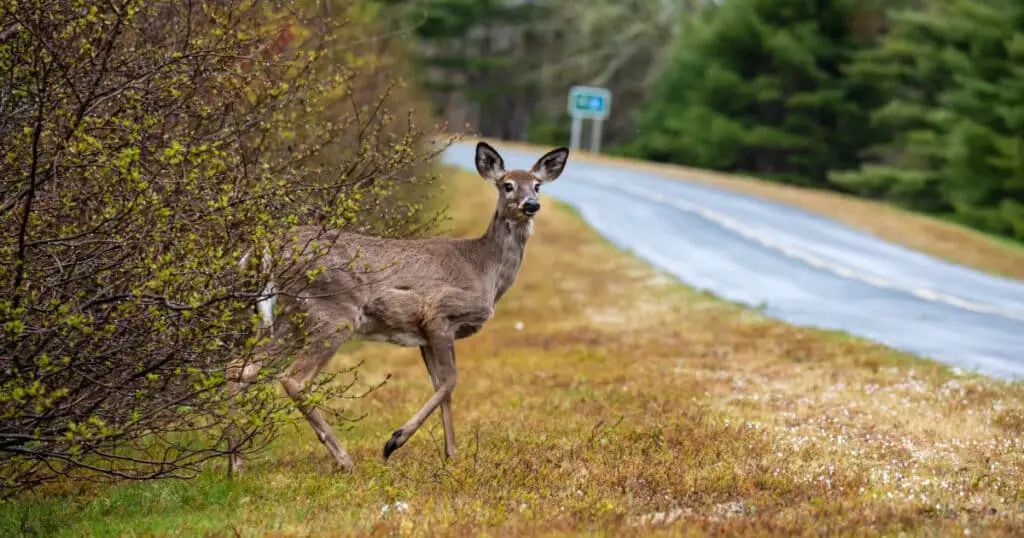Even though everyone would rather avoid the situation, hitting a deer with your vehicle is something that happens to almost everybody. Due to the populations of deer in some areas, the chances of hitting one are even higher. Killing a deer in a collision is sad, but what if the deer gets up and runs off after striking your vehicle? We get the question “I hit a deer but it ran off, now what?” a lot.
In today’s article we’ll tell you what to do next, what’s likely to happen to the deer, and try to answer all of your questions.
If you’ve hit a deer and it ran off, It’s very difficult to know the extent of damage or injury that may have occurred, so it’s good practice to call local authorities to report the incident.
In the event of hitting a deer, it can be a very stressful situation which may make it difficult to think clearly. Following a steady train of thought about the logical steps to take will help you ensure your own safety while also helping the deer by notifying the right people.
What To Do After Hitting A Deer?
The first thing you should do is remain calm and pull your vehicle over onto the shoulder to assess the damage to your car. This will allow you to safely evaluate the situation.
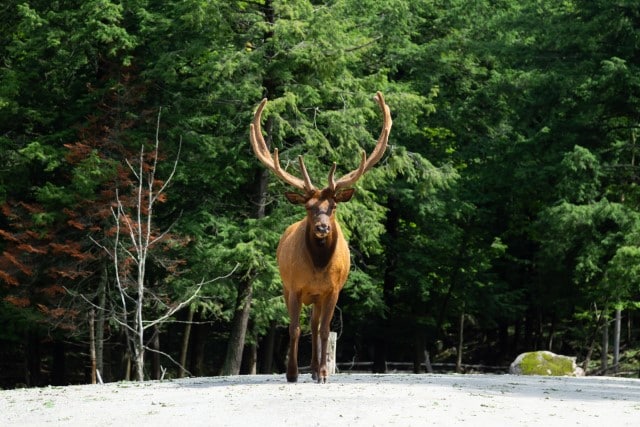
A lot of deer accidents happen at dawn or dusk. Deer are crepuscular, and not nocturnal. These are the times of day when they are most active. It’s difficult at this time of day for other drivers to see you, so it’s critical that you pull off to a safe area before exiting your vehicle.
Safely Examine Your Vehicle and Assess the Damage
It’s natural to want to examine the damage after a collision. But if you’re on a busy road, you need to get to a safe place before doing so.
It’s important to check your surroundings and make sure you’re in a safe area, away from traffic. If the deer has run off, it doesn’t necessarily mean the animal is okay, so you should always see if you can find any blood or fur at the scene.
Taking photos of your vehicle and any blood or fur you can find will help to establish evidence if you need to make an insurance claim to cover damages to your vehicle.
This can also help professionals understand if you seriously injured the deer.
Dashcams are a very popular tool to have in your car nowadays, and if you have one, it can be a great way to not only help you with insurance but also to help the deer.
Contact Authorities
After any accident in which a deer runs off after a collision, we recommend that you contact local authorities.
They will advise you on the best course of action.
They may ask for information regarding the incident, and if you have photos or dashcam footage, this may help animal response teams to locate the deer if needed.
It is important to remember that hitting a deer can cause serious injury or death. It is always best to remain vigilant and take action if necessary. If the animal looks severely injured, you should do your best to call an animal rescue or wildlife rehabilitation center for help.
What Can Happen To A Deer After You Hit It?
Deer can be very seriously injured after being hit by a car, regardless of the speed at which it was traveling.
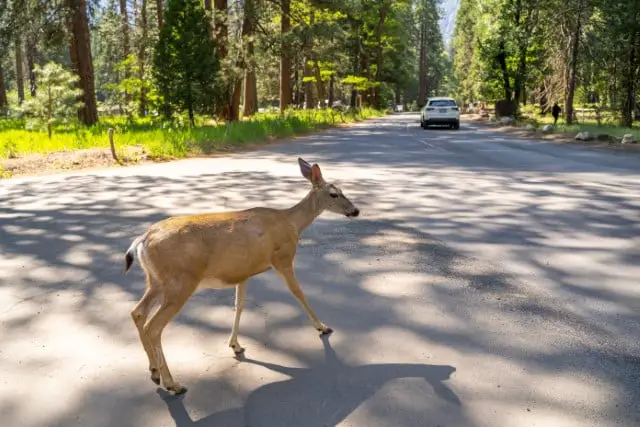
Common injuries include broken bones, cuts, bruises, and even internal injuries. Sometimes deer can be very lucky, and a harsh impact can leave the deer with minimal injury.
If it was a serious incident, the deer could quite clearly be injured and still run a fair distance into the nearby woods. In this case, it is very likely that the animal will suffer in silence and could die if not given help.
Why Injured Deer Are Able to Run Away
Even with severe internal injuries, deer are able to use adrenaline to escape, which is why you may see a deer running after being hit by a car. This is why it’s important to report the incident so that professionals can locate and help the animal if needed.
While it can be hard to process the event as its happening, it is a good idea to ensure that the deer is not left in a dangerous situation if possible.
If the animal looks severely injured, you should take action as soon as possible, as minor injuries can also become much more serious if left untreated for too long.
In certain areas of the United States, it is illegal to move injured wildlife due to health and safety reasons. It’s important to be aware of the regulations in your area and take care not to inadvertently break any wildlife laws.
If you hit a deer, it’s important to call local authorities and, if possible, monitor the animal from afar until help arrives. Your quick actions may help save its life, and that’s always worth being vigilant about.
The Scene Of The Accident Can Help You Gauge The Deer’s Health
If the deer runs off after being hit, it’s important to assess the scene of the accident in order to gauge the severity of the injury it may have sustained. While some accidents involving deer result in no major injury, sometimes the initial severity may not be obvious.
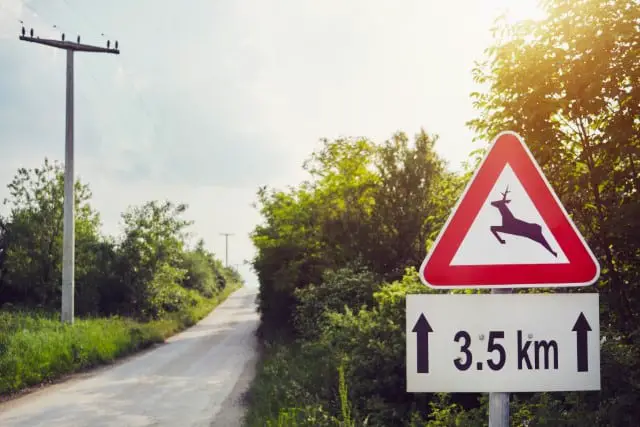
Taking a minute to pull over and inspect the area can help you determine if the deer may have serious injuries.
Identifying Signs of Injury
Look for evidence of a collision, such as broken branches, tracks in soft ground, or fur, that may indicate where the deer ran off.
Once you’ve found the path the deer has taken away from the scene, you can begin to look for a few telltale signs to help you determine the deer’s health.
Look for blood, broken bones, or excessive limping that could indicate a serious injury.
If the animal is in sight and is in clear distress, this is when you should immediately call any nearby animal rescue services to come and help. Other than that, if the deer appears to be okay or even just running away without any signs of injury, it could indicate that no major harm has been done.
Your Car and Speed Can Tell You A Lot
It can also be a good idea to consider the type of car you drive and whether or not you were going fast at the time of the impact.
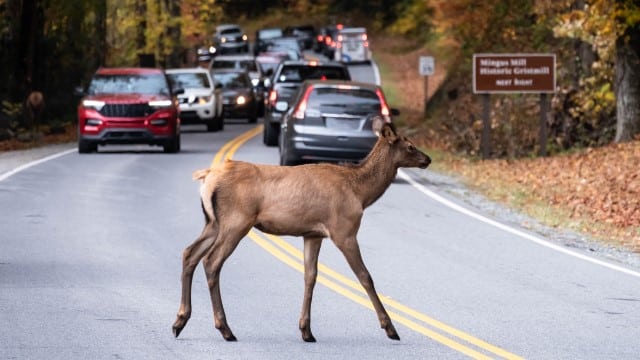
If you were traveling at high speeds and were unable to brake leading up to the accident, you can normally expect that the deer has been injured, as the force from any vehicle traveling over 40 mp/h will be enough to cause serious harm.
The type of car you drive is also important, as trucks and SUVs can cause more damage than smaller cars due to their size and mass.
Taking these things into consideration will help you give a better report to authorities also so they can gauge the severity of the accident and be able to react appropriately.
Legal Considerations After Striking A Deer With Your Vehicle
Many state do not require that you file a police report when you hit a deer. That said, if you intend to file for insurance compensation to cover repairs, you should file the report.
Some states, however, require that you report an accident with a deer if it has died. They may require that you report if you injured the deer and it requires assistance.
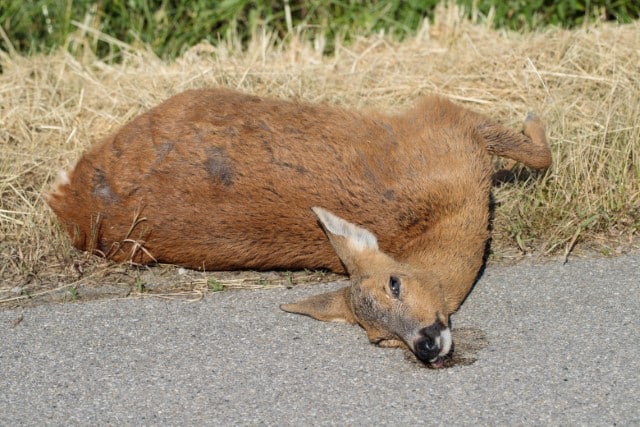
Regardless of where the accident takes place, if you have hit the animal and feel that it needs help, then it is best to contact your local authorities for the animal’s sake.
If you’ve swerved to avoid the deer and, in the process, hit another vehicle, then you should definitely file a police report. This should go without saying.
In some cases, the law may require that responding officers kill the deer if its injuries are grave.
This can be a difficult decision to make, so it’s best to defer to local authorities. They will know what is allowed in your area, and are trained to asses the animal’s health.
Deer Collisions and Insurance Claims
Insurance is one of the biggest complications that come from hitting a deer, especially if you have an injury from the incident or if someone in another vehicle has been injured. In any case of an accident involving a deer, gathering as much evidence as possible is the best course of action.
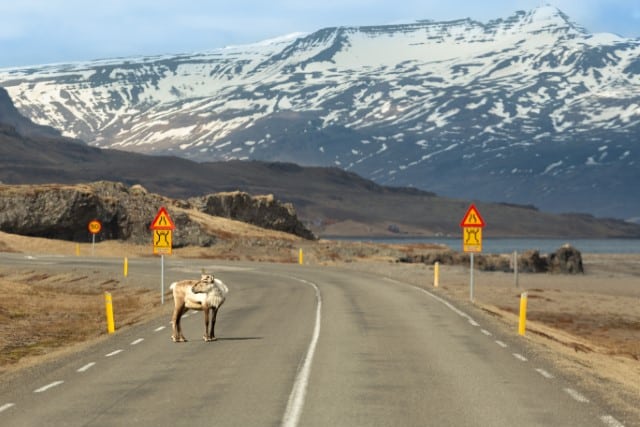
With dashcam footage being the best type of evidence, if you are able to gather any other evidence, such as photos or contact information from witnesses at the scene of the accident, that can definitely be beneficial when seeking a claim.
Lastly, always remember to take safety precautions when traveling around wildlife-filled areas. If you live somewhere with a large population of deer or other animals, investing in a dashcam and being aware while driving can be the best way to prevent any major expenses from an incident.
Tips To Avoid Hitting Deer In The Future
The best way to avoid hitting deer is to be aware of your surroundings and reduce speed while traveling through wildlife-filled areas.
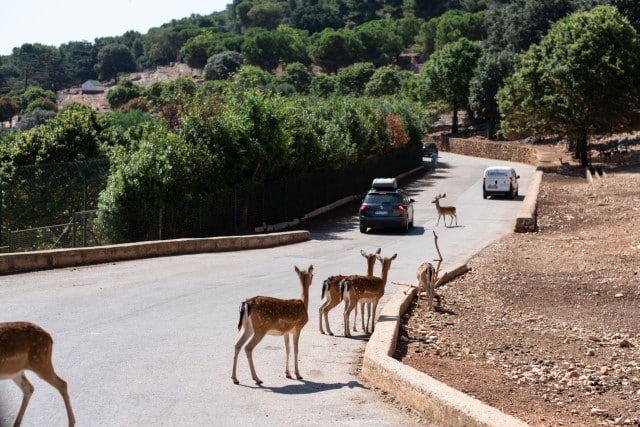
Driving slowly will greatly reduce the chances of a collision. Doing so makes it easier to spot the animal before it’s too late.
Be Aware of When Deer Move
Additionally, it’s important to be extra careful when driving during dawn or dusk, as these are the times when deer move most. When deer are active, you’re more likely to encounter them in roadways.
If you see a deer on the side of the road, instead of just slowing down, it’s best to stop completely if there isn’t much traffic behind you and wait until it moves away from the area before continuing.
Understand Deer Vision & Group Behavior
Deer eyesight is different from ours, so they may notice you until you’re right up on them.
Deer often move in small groups called herds. So even if you see one deer safely cross the road, it’s important to slow down because more may be in the brush at the side of the road about to follow.
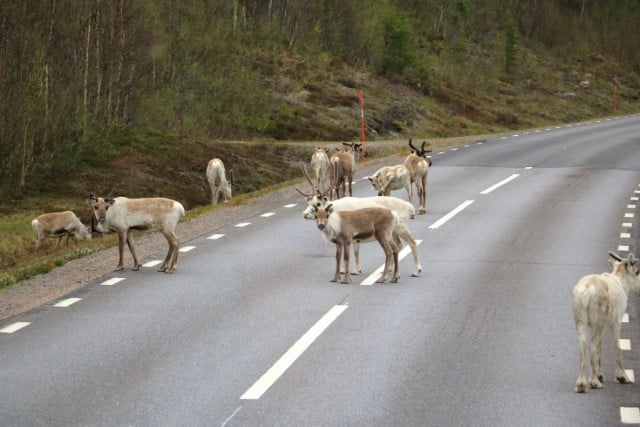
You can also be aware of signs that may be posted in your area warning drivers about deer activity. Take extra precautions when driving through these areas.
Vehicle Upgrades That May Help
If you live in an area with a large population of deer, you may choose to outfit your vehicle with headlight protectors or covers so that the bright lights don’t confuse or scare the deer into running across the road.
You may also choose to install a deer whistle.
Larger trucks and SUVs can’t always stop fast enough to avoid an incident, so it can be a good idea to fit a bullbar to the front of the car to minimize damage to your vehicle. While you may want to put the animal first, it is important to also consider the safety of yourself and other drivers.
Fixing a bullbar to the front of your vehicle can help prevent the deer from rolling up onto the windshield and potentially smashing it, causing cuts to the deer and sharp glass from entering the cabin of the vehicle.
Being aware, cautious, and alert are the keys to avoiding any accidents with wildlife.
If an accident occurs, inspect the area. This way you can determine if any further action needs to be taken.
Swerving may not always be the best action to take, so you should do so with caution.
Which is Worse – Swerving to Miss a Deer or Hitting It?
Swerving to miss a deer is one of the first reactions you may have in the event that one runs across the road. This can be a semi-safe option in some cases. However, it can also be very dangerous in certain situations.
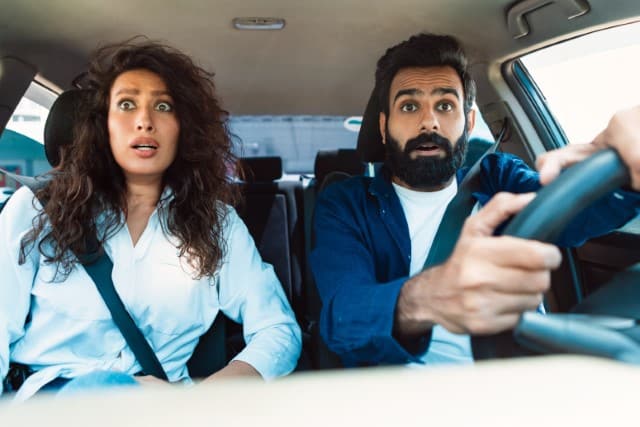
Swerving to miss a deer can be extremely hazardous as you may end up driving into the opposite lane of traffic or even off the road and onto a sidewalk or, worse yet, into a tree. This can cause serious injury to yourself and anyone else in the vehicle.
It may be viable to swerve if it is late and you are aware of the traffic in the oncoming lane and also if you are certain about the direction that the deer is traveling.
It’s very difficult to accurately gauge the direction a deer will move next. Deer can run fast, and are adept at making sharp turns without warning. This is something they do to evade predators.
This means that a deer can easily dart into an oncoming lane or even double back. This is why swerving to avoid a deer is generally not effective.
Slow Down or Stop if Possible
The best course of action is usually to slow down and attempt to stop if possible. If you drive over 40 mph, then stopping suddenly can be very dangerous. This is especially true on wet roads.
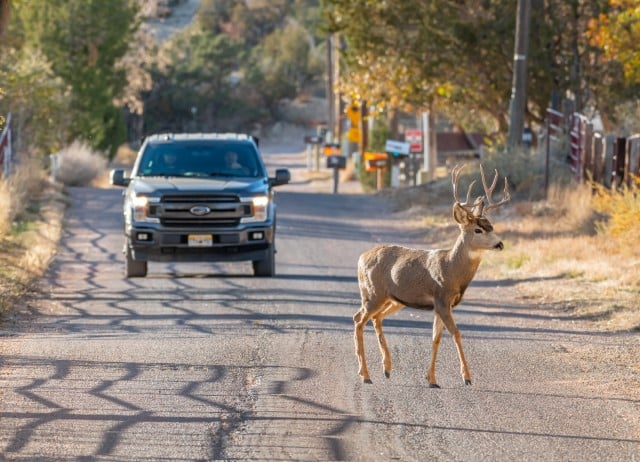
Gradual braking is the best way to avoid striking a deer. But that’s only possible if you’re traveling at a moderate speed.
Slamming on your brakes and swerving can be disastrous to you, your passengers, and other vehicles on the road.
At the end of the day, your safety comes first. After you’ve considered your safety and the safety of other road users, you can make an informed decision on whether or not to swerve.
If you hit a deer, there are a lot of things to consider legally for your own sake and for the sake of the deer’s health. While it can be hard to determine the best course of action in these situations, you should always make an effort to call the relevant authorities if the deer runs off.

